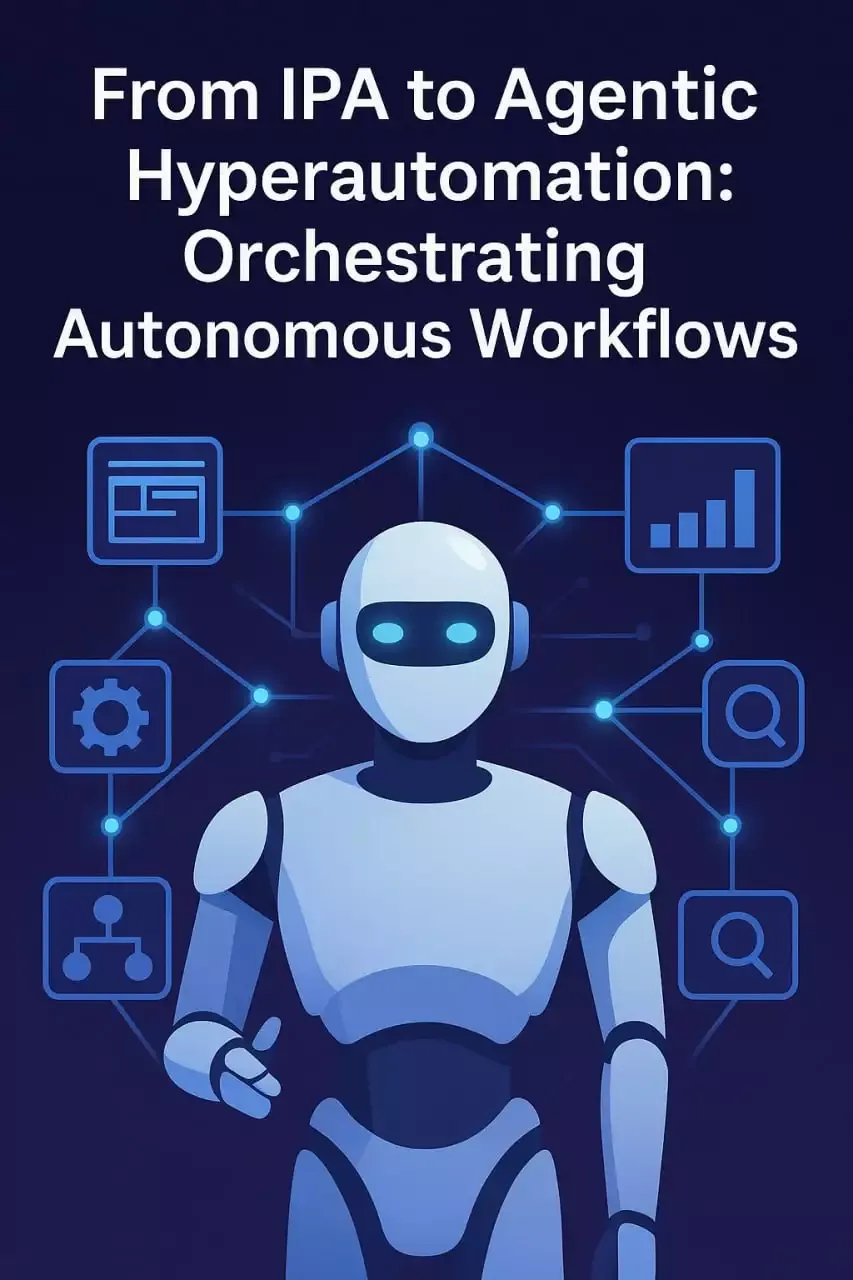From IPA to Agentic Hyperautomation: Orchestrating Autonomous Workflows
In the ever-evolving world of digital transformation, businesses are increasingly seeking ways to move beyond isolated automation solutions. Enter Agentic Hyperautomation — a next-generation approach that combines Intelligent Process Automation (IPA) with autonomous agents and orchestration engines. This evolution empowers organizations to automate not just repetitive tasks, but entire workflows that can adapt, learn, and optimize themselves over time.

Introduction
In the ever-evolving world of digital transformation, businesses are increasingly seeking ways to move beyond isolated automation solutions. Enter Agentic Hyperautomation — a next-generation approach that combines Intelligent Process Automation (IPA) with autonomous agents and orchestration engines. This evolution empowers organizations to automate not just repetitive tasks, but entire workflows that can adapt, learn, and optimize themselves over time.
What Is Agentic Hyperautomation?
Agentic Hyperautomation builds on the foundation of IPA, which integrates technologies such as Artificial Intelligence (AI), Machine Learning (ML), Business Process Management (BPM), and Robotic Process Automation (RPA). However, it goes further by introducing autonomous agents capable of making decisions, collaborating, and managing parts of a process without human intervention.
Unlike traditional automation scripts or bots, these agents possess contextual awareness and can dynamically adjust workflows based on changing conditions, user behavior, or business rules. Think of it as giving automation a “brain and senses.”
Key Components:
1.Autonomous Agents: Software entities capable of sensing their environment, reasoning through logic or data, and taking actions toward a goal.
2.Process Orchestration: The coordination of various tasks, agents, and APIs into cohesive workflows, often managed through a BPM engine.
3.AI/ML Models: Provide predictive and decision-making capabilities, such as forecasting demand or identifying anomalies.
4.RPA Bots: Handle repetitive and rule-based tasks like data entry or invoice matching.
5.Integration Layer: Connects internal systems (ERP, CRM, etc.) with external data sources and APIs.
How It Works in Practice
Imagine a manufacturing firm using IIPA’s platform. Instead of manually planning maintenance, a sensor agent detects anomalies in machine performance, triggering a predictive ML model. The agent orchestrates an RPA bot to generate a maintenance ticket, notify the technician, and reorder parts if inventory is low. All of this happens automatically and in real time.
Benefits of Agentic Hyperautomation
– Scalability: Once trained, agents can be reused or repurposed across business units.
– Adaptability: Systems can react to unexpected changes, such as supply chain disruptions.
– Reduced Latency: Decision-making happens at machine-speed.
– Continuous Improvement: With ML, agents can learn from outcomes and optimize over time.
Challenges to Consider
– Data Governance: Ensuring that agents make decisions based on accurate, compliant data.
– Change Management: Training teams to work with autonomous systems and trust their decisions.
– Integration Complexity: Connecting disparate systems in a unified architecture.
Implementation Roadmap
1.Process Discovery: Use tools to map current workflows and identify automation candidates.
2.Agent Design: Define agent goals, inputs, and actions. Establish performance metrics.
3.Orchestration Setup: Configure BPM engines or orchestration tools (e.g., Camunda, Apache Airflow).
4.Pilot and Test: Run sandbox scenarios to validate outcomes.
5.Deploy and Monitor: Launch into production and track key KPIs.
Strategic Use Cases
– Finance: Smart agents that reconcile transactions, flag fraud, and optimize cash flow.
– Manufacturing: Autonomous quality control and predictive maintenance.
– Customer Service: Multi-agent chatbots that understand context, escalate cases, and provide real-time assistance.
– Supply Chain: Dynamic inventory and logistics agents that reroute based on delivery risks or delays.
The Future Outlook
Agentic Hyperautomation represents a major leap toward fully autonomous enterprises. As these technologies mature, we’ll see entire departments run on orchestrated agents that collaborate seamlessly. The role of humans will shift toward oversight, creative problem-solving, and strategic decision-making.
Conclusion
For organizations looking to gain a competitive edge, Agentic Hyperautomation isn’t just another trend—it’s a transformational strategy. By integrating intelligent agents into your process automation roadmap, you can unlock a new era of operational efficiency, adaptability, and innovation.
Interested in how IIPA can support your journey toward autonomous process orchestration? Contact us to explore tailored solutions ([email protected]) or check out our online demo at iipa.io .